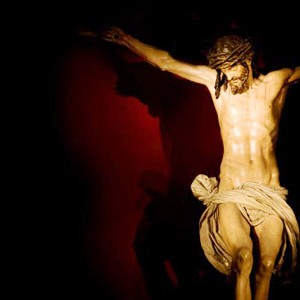by Fr. Patrick Henry Reardon
 In all three Synoptic Gospels the chief link between the Savior’s baptism and his Transfiguration is found in the Father’s identification of Jesus as His “beloved Son.” Only in Luke, however, does picture of Jesus at prayer join the two scenes.
In all three Synoptic Gospels the chief link between the Savior’s baptism and his Transfiguration is found in the Father’s identification of Jesus as His “beloved Son.” Only in Luke, however, does picture of Jesus at prayer join the two scenes.
Here we will reflect on Luke’s portrayal of the Transfiguration solely with respect to the theme at hand; namely, the Lord’s prayer and his Passion.
We should first observe the distinctive way Luke introduces the scene:
“Now it came to pass, about eight days after these sayings, that he took Peter, John, and James and went up on the mountain to pray” (Luke 9:28).
Neither Matthew nor Mark mentions the Lord’s prayer on this occasion. As in the case of Jesus’ baptism, the reference to prayer is a distinctive feature of Luke’s account.
Likewise, Luke alone refers to Jesus speaking of his suffering and death within the Transfiguration account. He writes,
“And behold, two men talked with him, who were Moses and Elijah, who appeared in glory and spoke of his exodus that he was going to fulfill (pleroun) at Jerusalem” (Luke 9:30-31).
Several features of this reference to the Passion are important to Luke’s theological view of the Transfiguration:
First, he uses the technical theological expression exodus to speak of Jesus’ coming death. The author thus indicates the soteriological meaning of the Lord’s death: It was an act of redemption—of liberation—from slavery. Jesus Passion rescued men from bondage. Such is the meaning of the Greek word, exodus, in this passage. It is evocative of Moses and Pharaoh and the drama of the Passover and the ten plagues.
Second, in his reference to Jesus’ exodus, Luke explicitly places the event “at Jerusalem.” This, too, corresponds to a theme in Luke’s Gospel, where the holy city is the culminating place of the narrative. Jerusalem is the city to which Jesus has
“steadfastly set His face to go” (Luke 9:51, 53; 13:22, 33).
Third, by referring to the Savior’s Passion within the Transfiguration story, Luke prepares for a later scene: the account of Jesus’ Agony. Among the Synoptics, only Luke will speak of that Agony taking place—like the Transfiguration—on a mountain (Luke 22:39-41). This image strengthens the link between the Transfiguration and the Passion.
Fourth, in his picture of Moses and Elijah—representing the Law and the Prophets—in discussion with Jesus about his coming exodus at Jerusalem, Luke highlights a major theme of his theology: the fulfillment (pleroun) of Holy Scripture in Jesus’ sufferings, death, and Resurrection.
In his portrayal of the Agony in the Garden Luke is at one with Matthew and Mark in making the Passion the subject of Jesus’ prayer to the Father. One of these items is, in fact, the very word “agony,” which he employs to describe the Lord’s experience of prayer (Luke 22:44). This word, now commonly used to refer to what took place in the Garden, comes exclusively from Luke’s account of it.
Luke also introduces other details, which enhance the vividness of the scene. To wit,
“And being in agony, he prayed more earnestly. Then his sweat became like great drops of blood falling down to the ground,” (Luke 22:43-44).
The theological significance of this detail is that Jesus’ bloodshed is caused first by himself, not his enemies. His complete obedience to the Father, conveyed in his prayer, brings about the initial libation of his redemptive blood, of which he had proclaimed just shortly before,
“This cup is the new covenant in my blood, which is shed for you” (Luke 22:20).
Prior to the appearance of his betrayer, then, Jesus commences the shedding of his blood. He begins to pour it out in the struggle of obedience, when as yet no hostile hand has been raised against him. As the life is in the blood (Leviticus 17:14), it is Jesus—not his enemies—who begins to pour it out in obedience to the Father’s will. In Luke’s account, then, the Agony is not a prelude to the Passion but its very commencement, because Jesus’ resolve to accomplish the Father’s will is what causes his blood to flow.
The priest himself pours out the libation.
